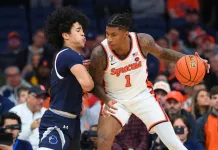The makeup of this year’s Final Four, fourth-seeded Connecticut joining first-timers San Diego State, Miami, and Florida Atlantic, should have every college basketball bettor examining the current state of the sport. The upset-heavy tournament we have witnessed so far feels like the beginning of a trend.
Perhaps if one or two top seeds stumbled along the way, it would be somewhat noteworthy. All of them bailing prior to the Elite Eight is significant. NIL money, the transfer portal and the movement of veteran players appear to be creating a new environment in which there isn’t much of a difference between high and mid-level seeds. f college basketball is entering a new era of parity, then bettors should learn from this year’s March Madness before building their 2024 futures portfolio.
Here are some points from this year’s tournament for futures bettors to consider moving forward.
Take it down a notch
The lack of any No. 1 seeds in the Final Four is an anomaly very few bettors or analysts saw coming. It has happened only three times since 1979 (1980, 2006, 2011). Those three Final Fours had at least one No. 2 or No. 3 seed represented.
Fans, media members, and bookmakers had such high expectations for Houston, Kansas and Alabama that the consensus opinion was at least one of them or a No. 2 seed like Arizona or UCLA had to win the tournament. That was certainly the logic I used when making college basketball futures wagers since it’s been the predominant trend since 1985. Well, those baseline beliefs that a high seed is an overwhelming favorite to win the tournament must be changed. Sure those No. 1 and No. 2 seeds will still nab national championships in the near future, but a futures portfolio doesn’t need to be top-heavy with them.
That should have always been the logic with futures bets made with value in mind, nonetheless, it needs to be stressed for next season. The incoming favorites for 2024 will look good talent-wise, but not so much with 10/15-1 odds after what happened to those teams this March. If teams on the 5-10 line can do what they did this season, it will prevent futures bettors from attempting to cover the board and hedge their plays by adding a couple of the favorites into their portfolio through the year.
With conference consolidation coming, expect to see those middle seeds populated by championship-level teams pushed back because of a few more regular season losses. Elite teams from the Big Ten or Big 12 in this range mean a mid-major riser like FAU goes lower and faces a top seed even earlier.
Futures bettors must change their mindset. Get rid of those expectations that the No.1 seeds will breeze into the Sweet 16. Don’t dismiss an 8-9 seed because of the lack of success they had in the past. These squads are going to be very close in analytics to the teams they will play in the second round.
Start next season’s handicapping by looking at some undervalued power conference teams coming off a down season but who added some new veteran transfers to the roster. Then come tournament time, don’t be hesitant about adding a 5-10 seed into the portfolio. Those might be available around 50-1. A team like this winning just two games against what could be comparable squads allows bettors in the words of Mike Palm to “monetize the ticket.”
More to come
The transfer portal is now a fundamental part of how coaches compose a roster, and that impacts futures betting in many ways. Therefore, it is going to be difficult to identify all the possible national championship contenders until there are enough games to see what the new roster projects towards.
Every team in the Final Four will start at least one player who transferred in from another school during his college career. Next year, wait until February to wager on the power conference teams that “look” like a national champ. Right now, all four teams still alive look like a national champion, but our perceptions, based on previous tournaments, were swayed because of their name and seeding.
Don’t be in a rush to bet on North Carolina, Duke or Kentucky, three teams that should be high on the 2024 odds board. In a tournament where there are fully equipped dogs, getting some closing line value on favorites isn’t worth it. Those top favorites will be around 10-1 in February and 4-1 once the tournament begins. Wait until those brackets come out before blindly betting on the favorites—the drop in odds will be necessary for the use of information.
Fade away
No matter the odds, it is going to be hard to put any futures on Purdue, Alabama, Houston and Kentucky. Betting on college basketball is not just about the players, it has a lot to do with the coach.
Matt Painter’s recent resume includes a historic loss to a #16 seed and a first-round exit in two of the past three tournaments. Purdue’s guard play was an issue along with the disappearance of Zach Edey down the stretch against Fairleigh Dickinson. Next year the Boilermakers will be older and get Edey again, but they still have Painter, a coach futures bettors should avoid.
Brandon Miller will be long gone from Tuscaloosa before Tide fans start thinking about the spring football game. His absence is not the reason to avoid Alabama. It is about Nate Oates who very likely had the best team he will ever coach in the tournament. His response to the SDSU defense was to allow his offense a strategy of playing just one pass and then a long-range chuck.
As for Houston, Kelvin Sampson has a Final Four to his credit, but the issue might be the ultra-physical style the Cougars rely on during the regular season. Next year, wait to wager on them prior to the tournament or just single games based on their health.
Kentucky will once again have an ultra-talented group in 2024 welcoming three of the top four high school recruits. They will be coached by John Calipari. His recruiting and in-game coaching methodology clearly are not working in Lexington. The Wildcats will be a popular public play because of the name and HS recruits, there is no reason to be swayed by the preseason hype.
Age is more than a number
It is going to be difficult to handicap tournament futures just based on age/experience, however, it seems to play a role. Bettors should make team age a weighted category in their team power rankings.
All the teams in the Elite Eight were above KenPom’s D1 average for experience and all over two years in D1. There is likely going to be only one true freshman start in the entire Final Four— UConn’s Alex Karaban.
When looking at mid-majors, KenPom’s continuity becomes important. Both FAU and SDSU were in the Top 40 nationally for that category. Conversely, freshman-heavy teams, even if they are filled with McDonald’s All-Americans, might not be as strong (mentally and physically) as they appear. A common phrase used for SDSU tournament wins was how they were men playing against boys.
KenPom’s continuity is going to be one of the more discussed analytic categories in 2024 for futures bettors looking at conference outrights and the national championship.
Bet on the best teams not the teams in the best conference
Looking back at the regular season success, Miami being in the Final Four shouldn’t be a surprise. Like many bettors, I looked past them and that was clearly a mistake. The Hurricanes had a Top 5 offense and tied for the most wins in the ACC.
SDSU and FAU were betting afterthoughts for many—not because of a lack of accomplishments. The Aztecs had a Top 5 defense, and the Owls were Top 30 for both KenPom offense and defense. It was a result of their conference affiliation. The stigma associated with a lack of national championship pedigree in the Mountain West and Conference USA, might have cost bettors a chance for a big tournament payday. If this same SDSU team played in the Pac-12 they would have gotten a lot more attention. C-USA with Charlotte, UAB and North Texas has been a March machine.
Now in the era of the transfer portal and parity bettors should become agnostic towards conference affiliation when making futures plays prior to the start of the tournament. The top mid-major teams that get a berth will have plenty of veterans with power conference experience, making them more of a legitimate candidate to win it all than ever before.
Even if UConn out of the Big East wins this year’s tournament, the divide between power conferences and mid-majors is shrinking, and value-minded bettors should have more interest in untraditional candidates next year.
The Big 12 has no teams in the Final Four and just two (out of seven tournament teams) made the Elite Eight. The second-best conference this year according to many experts, the Big Ten, had none reach the Elite Eight.
Don’t fall in love with C-USA. Next year it loses Charlotte, FAU, North Texas, Rice, UAB UTSA, Marshall, Old Dominion and Southern Mississippi. KenPom numbers, wins, and recent play needs to weigh far more in a bettors power ranking than its conference.
Unders
The first two rounds saw unders come in at a considerable pace over the first 48 games (32-16). Consider this another indication of how the gap between high seeds and low seeds has diminished.
A note to look out for once next year’s tournament starts is if players are once again having some issues with newer, slicker balls. Players need to adjust their shooting early on if that remains the case.
Spread it around
If bettors feel burned with their futures plays and concerned about this apparent parity setting in, they can take a different approach next year. Play fewer futures on teams to win the national championship and save those units to use prior to tournament tip-off—less risk and time having the book hold your money, but less of a payout as well.
An alternative futures portfolio can be made in March and based on teams to reach Sweet 16, Elite Eight and Regional winners after the brackets are released. The futures approach weighs examining matchups over ROI. These more conservative wagers come with a plus price for teams not seeded in the top spot and are good hedge pieces to use on established futures plays. DraftKings tends to be the first national sportsbook to offer these numbers.
The future is now
One of the most noticeable bets I witnessed during this year’s tournament while watching at different Atlantic City and Las Vegas sportsbooks was the Race to 10 and Race to 15. These race bets are becoming popular because every early in-game possession creates so much angst.
A made basket in a 9-8 game 5 minutes in can create a similar crowd response to a team winning the national championship. For the most part, the crowd is playing the dog since it comes with a plus payout. From a social standpoint, bettors want to join this group. It is like playing craps. Do you want to slap high-fives with strangers when the point comes or keep it to yourself quietly on the Don’t Pass Line?
Dogs only went 8-24 over the first round but those who hit like FDU at 5-1 against Purdue can help offset multiple losses.
Consistently loading up on favorites makes little sense when they are priced around -130. If a bettor is willing to lay that, might as well just go money line for the game when the extended period of time should reward the more talented team.





